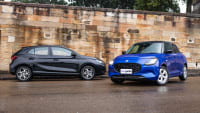While electric cars have taken Australia’s new-vehicle market by storm in the last few years, they have been quietly followed by a handful of electric commercial vehicles.
In fact, electrifying light commercial vehicles may be a better way to remove more emissions from the road per vehicle, as vans are estimated to travel around 150km a day, significantly more than the 30-40km average distance which passenger cars travel, and they’re predominantly powered by diesel.
The EV vans market is now expanding almost as rapidly as the passenger vehicle segment, with more and more brands racing to get zero emission vans as businesses look for ways to meet or exceed carbon or sustainability targets, or at least be seen to be trying.
There are several electric vans in Australia today and lots more are arriving soon.
What is an electric van?
Just like an electric car, electric vans swap the internal combustion engine out for a motor and batteries. The large floor area of a van allows for the batteries to be packaged neatly underneath, providing suitable range without compromising the van's key attributes - practicality and space.
On the surface electric vans may not seem to make sense. After all, unlike people’s private cars which typically only commute to and from work, a van is often used for daily deliveries which means extended driving throughout the day.
However, with most modern delivery businesses knowing how much driving each van must do in a day, coupled with the increased battery range, a modern electric van makes sense for an increasing number of businesses.
Add to that the fluctuations in fuel prices which means electric vans can be significantly cheaper to operate and there’s more reasons for making the switch.
For example, online shopping giant Amazon partnered with EV start-up Rivian to design a bespoke Amazon delivery van. The deal calls for 100,000 electric vans to be built in the coming years, which the companies claim has the potential to save “millions of metric tons of carbon per year” once all have been built and delivered.
How many electric vans are available in Australia, how do we compare to different parts of the world?
At the time of publication there are several electric vans available in Australia, the Ford e-Transit, LDV eDeliver 7 and eDeliver 9, Mercedes-Benz eVito, eSprinter, and EQV, Peugeot E-Partner and the Renault Kangoo E-Tech.
BYD also briefly offered its T3 electric van under its previous distributor, although it sold in very limited numbers.
The amount of electric vans in Australia is set to rapidly increase in the coming years, with the introduction of new models from established brands, as well as other offerings from new players like Skywell.
The best electric vans available to buy in Australia.
Peugeot Partner

The Peugeot E-Partner is the French brand’s small van. As its commercial range continues to be largely successful, expect this diminutive delivery van to be a key part of its electrification strategy.
Offering 3.9 square metres of storage space and a 100kW electric motor, the E-Partner sacrifices little in its switch to electric, although its driving range is 258km on the WLTP cycle.
Renault Kangoo E-Tech
.jpg)
The Kangoo was one of the first electric commercial vehicles available in Australia in its original Kangoo Z.E. form. This city-sized van is Renault’s direct rival to Peugeot’s E-Partner. It is similarly specified utilising a 90kW/245Nm front-mounted electric motor paired with a relatively small 45kWh battery pack allowing a WLTP-certified 286km driving range (unladen).
LDV eDeliver 7
.jpg)
LDV’s eDeliver 7 is the mid-sized follow-up to its eDeliver 9 large electric van. It offers more up-to-date battery tech and new electric motors, alongside a more modernised cabin experience. Alongisde these traits, it also offers HiAce-rivalling hauling specs and a choice of three body styles and two battery capacities.
Ford E-Transit

While local management probably would have preferred the Mustang Mach-E or F-150 Lightning, the tip of the spear for the blue oval’s electric future was a van.
Powered by a 190kW/430Nm electric motor that powers the rear wheels, the E-Transit launched with a driving range of 317km thanks to a 68kWh battery. Ford claims it will charge from a conventional outlet in eight-hours but on a DC fast charger it can go from 15 to 80 per cent in just 34 minutes.
Because the batteries and motor are mounted under the floor, Ford says no cargo space has been lost, which means 11.5 cubic-metres of room.
Mercedes-Benz eVito
.jpg)
If you want a Mercedes electric van you’re in luck, because the German luxury brand has introduced not one, but three battery-powered vans including the eVito commercial vehicle. It sits alongside the incoming EQV people mover and eSprinter large van.
At the time of writing, the eVito was available in one spec level, the eVito 112 LWB priced at $98,951. It is powered by an 85kW/360Nm electric motor supported by a 60kWh battery pack.
The eVito is alternatively available as a eVito Tourer 129 Medium Wheelbase people mover, which has a more powerful 150kW/365Nm electric motor and a larger 90kWh battery pack. At the time of writing, this version was priced from $137,515, before on-road costs.
Other electric vans available in Australia
.jpg)
Outside our top five picks, there are also some notable examples on-sale like LDV’s eDeliver 9 (although its 90km/h top speed is somewhat limiting). Mercedes also offers a range of electric vans currently, including the EQV luxury van, and the eSprinter large van. When it comes to people movers, you can also consider the LDV Mifa 9, although Australia is yet to see an electric minivan launch.
Electric vans coming soon to Australia
.jpg)
Competition in the van market, which can be quite lucrative thanks to fleet contracts, is set to heat up in 2025 with the arrival of several models from big-name automakers, as well as some newcomers.
Ford E-Transit Custom
.jpg)
On-sale before the end of 2024, the E-Transit custom will sit a size below the E-Transit large van in Ford’s range. Expect it to wear a price-tag somewhat under that of the $89,990 E-Transit, and like many of its rivals it will only be available as a long-wheelbase body style in either standard or high-roof forms.
Expect three-across front seating, as well as a powerful 160kW/415Nm electric motor, paired with a 64kWh battery pack good for a WLTP-certified 308km driving range.


.jpg)
.jpg)

.jpg)
.jpg)
.jpg)




.jpg)


.jpg)
.jpg)
.jpg)

.jpg)

